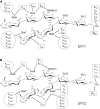Molecular landscape of BoNT/B bound to a membrane-inserted synaptotagmin/ganglioside complex
- PMID: 36006520
- PMCID: PMC11073447
- DOI: 10.1007/s00018-022-04527-4
Molecular landscape of BoNT/B bound to a membrane-inserted synaptotagmin/ganglioside complex
Abstract
Botulinum neurotoxin serotype B (BoNT/B) uses two separate protein and polysialoglycolipid-binding pockets to interact with synaptotagmin 1/2 and gangliosides. However, an integrated model of BoNT/B bound to its neuronal receptors in a native membrane topology is still lacking. Using a panel of in silico and experimental approaches, we present here a new model for BoNT/B binding to neuronal membranes, in which the toxin binds to a preassembled synaptotagmin-ganglioside GT1b complex and a free ganglioside allowing a lipid-binding loop of BoNT/B to interact with the glycone part of the synaptotagmin-associated GT1b. Furthermore, our data provide molecular support for the decrease in BoNT/B sensitivity in Felidae that harbor the natural variant synaptotagmin2-N59Q. These results reveal multiple interactions of BoNT/B with gangliosides and support a novel paradigm in which a toxin recognizes a protein/ganglioside complex.
Keywords: Botulinum neurotoxin type B; Gangliosides; Molecular modelling; Synaptotagmin.
© 2022. The Author(s), under exclusive licence to Springer Nature Switzerland AG.
Conflict of interest statement
The authors declare that they have no conflict of interest.
Figures






Similar articles
-
Gangliosides interact with synaptotagmin to form the high-affinity receptor complex for botulinum neurotoxin B.Proc Natl Acad Sci U S A. 2019 Sep 3;116(36):18098-18108. doi: 10.1073/pnas.1908051116. Epub 2019 Aug 20. Proc Natl Acad Sci U S A. 2019. PMID: 31431523 Free PMC article.
-
Synaptotagmin II and gangliosides bind independently with botulinum neurotoxin B but each restrains the other.Protein J. 2014 Jun;33(3):278-88. doi: 10.1007/s10930-014-9557-y. Protein J. 2014. PMID: 24740609
-
Botulinum neurotoxin G binds synaptotagmin-II in a mode similar to that of serotype B: tyrosine 1186 and lysine 1191 cause its lower affinity.Biochemistry. 2013 Jun 4;52(22):3930-8. doi: 10.1021/bi4003502. Epub 2013 May 17. Biochemistry. 2013. PMID: 23647335
-
Two Feet on the Membrane: Uptake of Clostridial Neurotoxins.Curr Top Microbiol Immunol. 2017;406:1-37. doi: 10.1007/82_2016_48. Curr Top Microbiol Immunol. 2017. PMID: 27921176 Review.
-
Variations in the Botulinum Neurotoxin Binding Domain and the Potential for Novel Therapeutics.Toxins (Basel). 2018 Oct 20;10(10):421. doi: 10.3390/toxins10100421. Toxins (Basel). 2018. PMID: 30347838 Free PMC article. Review.
Cited by
-
Presynaptic targeting of botulinum neurotoxin type A requires a tripartite PSG-Syt1-SV2 plasma membrane nanocluster for synaptic vesicle entry.EMBO J. 2023 Jul 3;42(13):e112095. doi: 10.15252/embj.2022112095. Epub 2023 May 25. EMBO J. 2023. PMID: 37226896 Free PMC article.
-
Lipid rafts and human diseases: why we need to target gangliosides.FEBS Open Bio. 2023 Sep;13(9):1636-1650. doi: 10.1002/2211-5463.13612. Epub 2023 Apr 20. FEBS Open Bio. 2023. PMID: 37052878 Free PMC article. Review.
-
Botulinum neurotoxin A mutants with enhanced ganglioside binding show improved potency and altered ganglioside selectivity.Commun Chem. 2025 Jun 4;8(1):171. doi: 10.1038/s42004-025-01569-0. Commun Chem. 2025. PMID: 40467754 Free PMC article.

